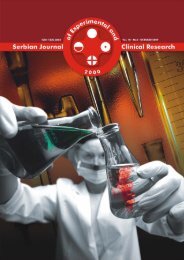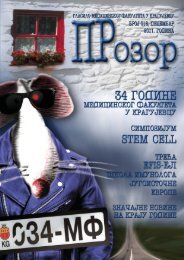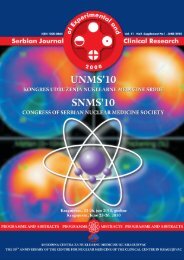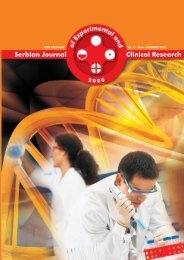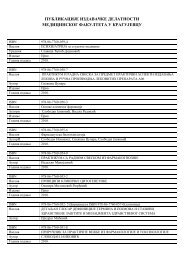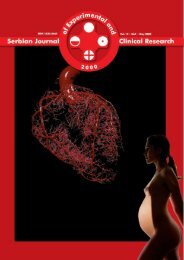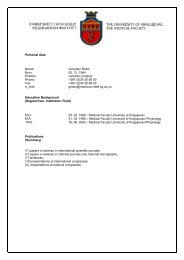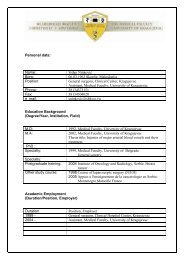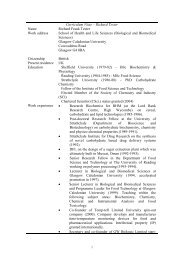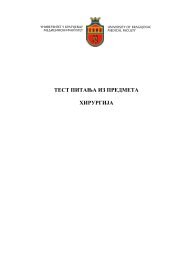Mouse/rat model Phenotype ReferenceIR +/- Mild insulin resistance 53, 54IR -/- Severe hyperglycemia, neonatal death from ketoacidosis 54IRS-1 -/-Mild insulin resistance, normoglycemia,55elevated serume triglycerides, hypertension, growth retardationIRS-2 -/- Insulin resistance, hyperglycemia, reduced beta-cell mass 56IRS-1 -/- IRS-3 -/- Hyperglycemia, lipatrophy, decreased plasma levels <strong>of</strong> leptin, hyperinsulinemia 57IRS-1+/- IR +/- Insulin resistance, beta-cell hyperplasia 58GK -/- Hyperglycemia, perinatal death 59GK +/- Glucose intolerance 59GLUT4 -/-Mild changes in glucose hemostasis, growth retardation, reduction <strong>of</strong> fat, 60cardiac hypertrophyPPARγ +/- Mild insulin resistance 61PPARγ2 -/- Insulin resistance, reduction <strong>of</strong> white adipose tissue 62PPARα -/- No phenotypical defect without pharmacological intervention 63hIAPP +/+ rat Decreased proliferation <strong>and</strong> increased apoptosis <strong>of</strong> beta cell,64hyaline replacement <strong>of</strong> islet cellshomozygous (-/-), heterozygous (-/+)Table 2. Transgenic <strong>and</strong> knockout models <strong>of</strong> Diabetes mellitusThe first knockout models <strong>of</strong> insulin resistance aimedat the disruption <strong>of</strong> major molecules in insulin receptor(IR) signaling. Heterozygous IR knockout mice show50% <strong>of</strong> IR expression, which is sufficient for the maintenance<strong>of</strong> physiological blood glucose contentrations (53).In contrast, homozygous IR-deficient mice rapidly developdiabetic ketoacidosis <strong>and</strong> die within 3-7 days after birth,showing the central role <strong>of</strong> IR in glucose metabolism (54).Aside from IR knockouts, various molecules <strong>of</strong> the signaltransduction pathway initiated by IR have been disrupted,such as insulin receptor substrates (IRS-1, IRS-2, IRS-3)(55-58). Insulin resistance <strong>and</strong> insulin secretory defectshave also been presented by a generation <strong>of</strong> mice deficientin beta cell glucokinase (GK). The heterozygous beta cellGK knockout mouse is characterised by decreased insulinsecretion in response to glucose (59). The homozygousknockout mouse model with a disrupted gene for theglucose transporter 4 (GLUT4), which mediates glucosetransport in muscle <strong>and</strong> adipose tissue in response to insulin,is characterised by mild changes in glucose hemostasis,growth retardation, reduction <strong>of</strong> fat <strong>and</strong> cardiac hypertrophy(60). The important physiological role <strong>of</strong> peroxisomeproliferator-activator receptors (PPARα <strong>and</strong> PPARγ) wasdeduced from findings identifying the PPARs as primarytargets <strong>of</strong> tiasolidinedione insulin sensitizers <strong>and</strong> fibratesthat have been used in the successful treatment <strong>of</strong> diabetes<strong>and</strong> dyslipidemia. Diverse knockout models have been createdto study the function <strong>of</strong> single PPARs is<strong>of</strong>orms (61-63). Similar to other mouse models, a transgenic humanislet amyloid polypeptide-expressing rat has been recentlydeveloped (64). This model shows pancreatic amyloidosis,insulin resistance, <strong>and</strong> reduced β-cell mass with resultinghyperglycemia (64). Some <strong>of</strong> the transgenic/knockout <strong>and</strong>tissue-specific knockout models are presented in Table 2.REFERENCES1. Rees DA, Alcolado JC. Animal models <strong>of</strong> diabetes mellitus.Diabetic medicine 2005; 22: 359-370.2. Wilson GL, LeDoux SP. The Role <strong>of</strong> Chemicals in the Etiology<strong>of</strong> Diabetes Mellitus. Toxicologic Pathology 1989; 17(2): 357.3. Wang Z, Gleichmann H. GLUT2 in pancreatic islets: crucialtarget molecule in diabetes <strong>induced</strong> with multiple lowdoses<strong>of</strong> streptozotocin in mice. Diabetes 1998; 47: 50-56.4. Zahner D, MalaisseWJ. Kinetic behaviour <strong>of</strong> liver glucokinasein diabetes, I, Alteration in streptozotocindiabeticrats. Diabetes Res 1990; 14: 101-108.5. Bolzan AD, Bianchi MS. Genotoxicity <strong>of</strong> streptozotocin.Mutat Res 2002; 512: 121-134.6. Nugent DA, Smith DM, Jones HB. A Rewiew <strong>of</strong> Islet <strong>of</strong>Langerhans Degeneration in Rodent Models <strong>of</strong> Type 2Diabetes. Toxicologic Pathology 2008; 36(4): 529-551.7. Wada R, Yagihasi S. Nitric oxide generation <strong>and</strong> poly(ADP ribose) polymerase activation precede beta-celldeath in rats with a single high-dose injection <strong>of</strong> streptozotocin.Virchows Arch 2004; 444: 375-82.8. Peiper AA, Brat DJ, Krug DK, Watkins CC, GuptaA, BlackshawB S, Verma A, Wang ZQ, Snyder SH.Poly(ADP-ribose) polymerase-deficient mice are protectedfrom streptozotocin-<strong>induced</strong> diabetes. Proc NatlAcad Sci USA 1999; 96: 3059-62.9. Cardinal JW, Allan DJ, Cameron DR. Poly(ADP-ribose)polymerase activation determines strain sensitivity tostreptozotocin-<strong>induced</strong> β cell death in inbred mice. JMol Endocrinol 1999; 22: 65-70.10. Mensah-Brown EP, Stosic Grujicic S, Maksimovic D,Jasima A, Lukic ML. Downregulation <strong>of</strong> apoptosis in thetarget tissue prevents low-dose streptozotocin-<strong>induced</strong>autoimmune diabetes. Mol Immunol 2002; 38: 941-946.33
11. Lewis JT, Foglia VG, Rodriguez RR. The effects <strong>of</strong> steroidson the incidence <strong>of</strong> diabetes in rats after subtotalpancreatectomy. Endocrinology 1950; 46: 111-21.12. Yomemura Y, Takashima T, Matsuki N, Hagino S, SawaT, Takashima S, Miwa K, Miyazaki I. The pathogenesis<strong>of</strong> diabetes produced by subtotal pancreatectomyp,with special reference to the cell kinetics <strong>of</strong> the isletcells. Nippon Geka Gakkai Zasshi 1984; 85: 356-62.13. Laybutt DR, Gl<strong>and</strong>t M, Xu G, Ahn YB, Trivedi N, Bonner-WeirS, Weir GC. Critical reduction in beta-cellmass results in two distinct outcomes over time. Adaptionwith impaired glucose tolerance or decompensateddiabetes. J Biol Chem 2003; 278: 2997-3005.14. Rossetti L, Shulman GI, Zawalich W, DeFronzo RA. Effect<strong>of</strong> chronic hyperglycaemia on in vivo insulin secretionin partially pancreatectomized rat.J Clin Invest1887; 80: 1037-1044.15. Lampeter EF, Tubes M, Klemens C, Brocker U, FriemannJ, Kolb-Bach<strong>of</strong>en V, Gries FA, Kolb H. Insulitis<strong>and</strong> islet-cell antibody formation in rats with experimentallyreduced beta-cell mass. Diabetologia 1995;38: 1397-04.16. Hanafusa T, Miyagawa J, Nakajima H, Tomita K, KuwajimaM, Matsuzawa Y, Tarui S. The NOD mouse. DiabetesResearch <strong>and</strong> Clinical Practice 1994; 24: 307-311.17. Fijino-Kurihara H, Fujita H, Hakura $, Nonaka K, TaruiS. Morphological aspects <strong>of</strong> non-obese diabetic (NOD)mice. Virchows Arch 1885; 149: 107-120.18. Miyazaki A, Hanafusa T, Yamada K. Predominance <strong>of</strong>T lymphocytes in pancreatic islets <strong>and</strong> spleen <strong>of</strong> prediabeticnon-obese diabetic (NOD) mice: a longitudinalstudy. Clin Exp Immunol 1985; 60: 622-630.19. Wong FS, Janeway CA Jr. Insulin-dependent diabetesmellitus <strong>and</strong> its animal models. Curr Opin in Immunol1999; 11: 643-647.20. Murphy K, Travers P, Walport M. Janeways Immunobiology.Garl<strong>and</strong> Science 2008; Chapter 14: 600-609.21. Serreze DV, Leiter EH. Genetic <strong>and</strong> pathogenic basis <strong>of</strong>autoimmune diabetes in NOD mice. Curr Opin in Immunol1994; 6: 900-906.22. Wicker LS, Clark J, Fraser HI et all. Type 1 diabetesgenes <strong>and</strong> pathways shared by humans <strong>and</strong> NOD mice.Journal <strong>of</strong> Autoimmunity 2005; 25: 29-33.23. Lally FJ, Ratcliff H, Bone AJ. Apoptosis <strong>and</strong> disease progressionin the spontaneosly diabetic BB/S rat. Diabetologia2001; 44: 320-324.24. Bortel R, Waite DJ, Whalen BJ, Todd D, Leif JH, LesmaE et all. Levels <strong>of</strong> Art2+ cells but not soluble Art 2 proteincorelate with expression <strong>of</strong> autoimune diabetes inthe BB rat. Autoimmunity 2001; 33: 199-211.25. Wallis RH, Wang K. Type 1 Diabetes in the BB rat: APolygenic Disease. Diabetes 2009; 58(4): 1077-11.26. Surwit RS, Kuhn CM, Cochrane C, McCubbin JA, FeinglosMN. Diet-<strong>induced</strong> type 2 diabetes in C57BL/6Jmice. Diabetes 1988; 37: 1163-1167.27. Rebuffe-Scrive M, Surwit RS, Feinglos MN et al. Regionalfat distribution <strong>and</strong> metabolism in a new mousemodel (C57BL/6J) <strong>of</strong> non-insulin-dependent diabetesmellitus. Metabolism 1993; 42: 1405-1409.28. Winzell MS, Ahren B. The high-fat diet-fed mouse Amodel for studying <strong>mechanisms</strong> <strong>and</strong> treatment <strong>of</strong> imparedglucose tolerance <strong>and</strong> type 2 diabetes. Diabetes2004; 53(3): S215-S219.29. Parekh PI, Petro AE, Tiller JM et al. Reversal <strong>of</strong> diet<strong>induced</strong>obesity <strong>and</strong> diabetes in C57BL/6J mice. Metabolism1998; 47: 1089-1096.30. Shimabukuro M, Zhou YT, Moshe L, Unger RH. Fattyacid-<strong>induced</strong> β cell apoptosis: a link between obesity <strong>and</strong>diabetes. Proc Natl Acad Sci USA 1998; 95: 2498-502.31. Hull RL, Kodama K, Utzschneider KM, Carr DB, PrigeonRL, Kahn SE. Dietary fat-<strong>induced</strong> obesity in miceresults in beta cell hyperplasia but not increased insulinrelease: evidence for specificity <strong>of</strong> impaired beta celladaptation. Diabetologia 2005; 48: 1350-1358.32. Bisbis S, Bailbe D, Tormo MA, Picarel-Blanchot F, DerouetM, Simon J, Portha B. Insulin resistance in the GKrat: decreased receptor number but normal kinase activityin liver. Am J Physiol 1993; 265: E807-813.33. Portha B, Giroix MH, Serradas P, Gangrenau MN, MovassatJ, Rajas, F, Bailbe D, Plachot C, Mithieux G, &Marie, JC. (2001). Beta-cell function <strong>and</strong> viability in thespontaneously diabetic GK rat: information from theGK/Par colony. Diabetes 2001; 50: S89-93.34. Ostenson CG, Khan A, Abdel-Halim SM, Guenifi A,Suzuki K, Goto Y, Efendic S. Abnormal insulin secretion<strong>and</strong> glucose metabolism in pancreatic isletsfrom the spontaneously diabetic GK rat. Diabetologia1993; 36: 3-8.35. Alvarez, C, Bailbe D, Picarel-Blanchot F, Bertin E,Pascual-Leone AM, Portha B. Effect <strong>of</strong> early dietary restrictionon insulin action <strong>and</strong> secretion in the GK rat,a spontaneous model <strong>of</strong> NIDDM. Am J Physiol EndocrinolMetab 2000; 278 : E1097-103.36. Guenifi A, Abdel-Halmi SM, Hoog A, Falkmer S, OstensonCG. Preserved beta-cell density in the endocrinepancreas <strong>of</strong> young, spontaneously diabetic Goto-Kakizaki (GK) rats. Pancreas 1995; 10: 148-153.37. Matsuoka T, Kajimoto Y, Watada H, Umayahara Y,Kubota M, Kawamori R, Yamasaki Y, Kamada T. Expression<strong>of</strong> CD38 gene, but not <strong>of</strong> mitochondrial glycerol-3-phosphate dehydrogenase, is impaired in pancreaticislets <strong>of</strong> GK rats. Biochem Biophys Res Commun 1995;214: 239-246.38. Ohneda M, Johnson JH, Inman LR, Chen L, SuzukiK, Goto Y, Alam T, Ravazzola M, Ocri L, Unger RH.GLUT2 expression <strong>and</strong> function in the beta-cells <strong>of</strong> GKrats with NIDDM. Dissociation between reductions inglucose transport <strong>and</strong> glucose-stimulated insulin secretion.Diabetes 1993; 42: 1065-1072.39. Homo-Delarche F, Calderari S, Irminder JC, GangnerauMN, Coulaud J, Rickenbach K, Dolz M, HalbanP, Portha B. Islet inflammation <strong>and</strong> fibrosis in a spontaneousmodel <strong>of</strong> type 2 the GK rat. Diabetes 2006;55: 1625-1633.34



